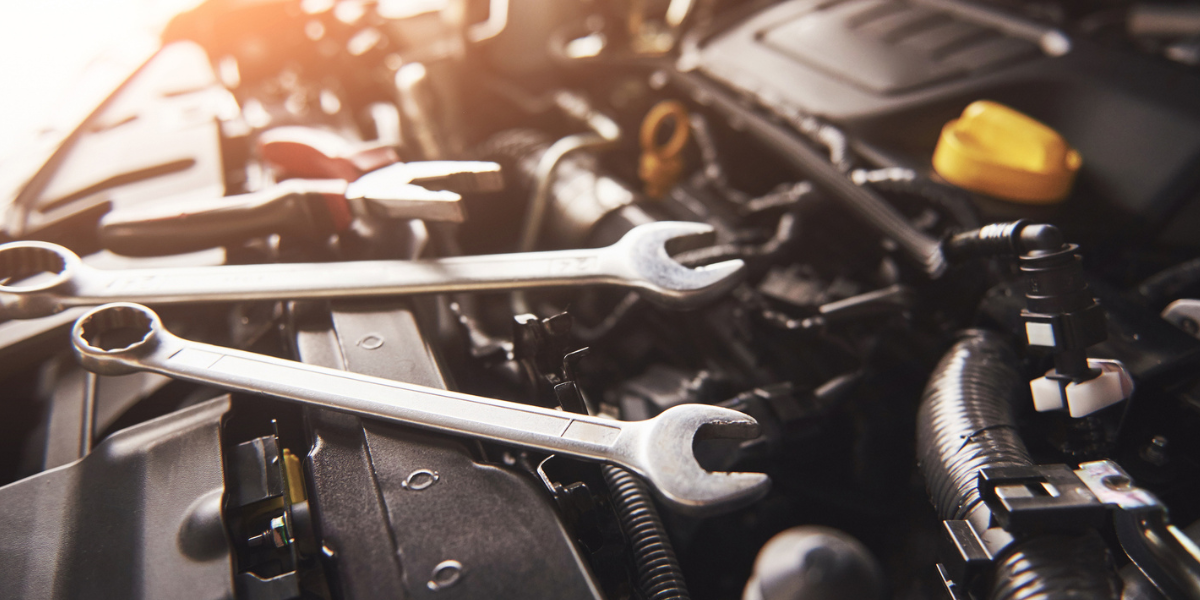In construction unplanned downtime events can disrupt projects, lower productivity and push out deadlines. The average cost of a downtime can soar to over $25,000 to over half a million dollars for larger organizations. Recurrent breakdowns can turn profits into losses, put future projects in jeopardy, and raise a panic situation for equipment managers looking after machinery maintenance.
When there is no proper maintenance plan in place, the costs trickle down to create a ripple effect. A single hydraulic failure at a site can idle an entire crew, push back timelines, and trigger costly overtime. Unsupervised equipment can also become a safety hazard if left for too long. Worn out brakes, loose tracks, or failing hydraulic systems can cause on-site accidents. In the long run, neglected maintenance slowly erodes fleet health, inflates fuel consumption, shortens asset lifespan and increases total cost of ownership.
A successful machinery maintenance plan doesn’t always just fix what’s broken. It focused on how to run construction projects in a smooth, safe and profitable manner. This blog will walk you through the fundamentals of construction machinery maintenance, how to set up the right service schedule, and where tools can help automate these tasks.
Start saving on maintenance
Understanding machinery failure
Before we delve into how to set up the correct maintenance strategy for your equipment, let’s quickly explore unplanned breakdowns. According to a study carried out in 2018, aging equipment contributes to around 44% of unplanned downtime events while human error accounts for another 16%.
Taking this information into account is important as an equipment manager you can brief your supporting site super to keep an eye for these incidents. These factors can be curbed to some extent with the help of a preventive maintenance program.
Building a machinery maintenance program that actually works
A preventive maintenance plan helps minimize the chances of breakdowns before they actually happen and stall work. Your goal while setting up machinery maintenance is simple. Fix more, spend less and optimize equipment performance.
Preventive maintenance (planned downtime) vs Emergency repairs (run to failure) for heavy machinery
byu/s_works_ inmining
1. Start with an accurate inventory
The first thing you need to do before setting up your maintenance plan in place is to account for what you have. Build a detailed inventory of every machinery you own, from excavators to bulldozers, compressors, and generators. For each asset, record:
- Make, model, and serial number
- Usage data (hours run, mileage, operating cycles)
- Condition rating (excellent, fair, poor)
- Location and assigned crew
- Maintenance and warranty history
This database will now become your starting point for building a maintenance strategy. All records will be linked with a work order listing all maintenance details at one place. You can then migrate this data into a computerized maintenance management system (CMMS) and track maintenance tickets in real-time.
2. Define realistic maintenance intervals
A common issue that arises when setting maintenance schedules is not knowing how often to set the recurrence. On the plus side, you don’t need to build your maintenance intervals from scratch. They are already provided by the manufacturers for most equipment. Half of your work is already done. However, construction environments rarely follow any rules. Dust, load, stress, and climate can all interchangeably affect how wear and tear sets in.
To create realistic intervals:
- Start with OEM recommendations as your foundation.
- Adjust using site data. If excavators are working double shifts, shorten the service interval.
- Use historical data to spot patterns (e.g., certain assets failing after 300 hours).
- Automate triggers using usage data or telematics feeds to prevent human error.
The goal is a maintenance cadence that reflects how you actually operate rather than what the manual says.
3. Assign ownership and accountability
When everyone on site is busy fixing equipment or handling delays, maintenance ownership gets blurred, based on the example discussed below:
A question on who does the Daily Maintenance on Heavy Equipment.
byu/MoutainGem inheavyequipment
Make it a point to be very clear about who is responsible for doing what;
- Operators perform daily inspections and report anomalies.
- Site Supervisors verify checklists and approve machine downtime.
- Equipment Managers schedule maintenance, analyze performance, and approve high-value repairs.
- Technicians execute scheduled work orders and record service outcomes.
This makes your job easier as people know who is supposed to be doing what. Giving your team a structure ensures inspections don’t get skipped and repairs don’t sit waiting to happen.
Get your maintenance sorted
4. Prioritize high-value equipment
Machinery maintenance can be prioritized according to the value associated with the equipment. Not all machinery deserves equal attention. An idle excavator is inconvenient, a broken excavator can halt operations. To avoid investing money in the wrong equipment, make a hierarchy that ranks tools by operational impact.
Here is a table showing you how you can set maintenance priorities for your equipment based on its impact:
| Tool / Machinery | Primary Reason for Maintenance | Impact if Left Unmaintained |
| Excavator | Hydraulic system inspection, undercarriage wear, and engine servicing. | Hydraulic leaks can cause total system failure; project stoppage and costly oil contamination cleanup. |
| Wheel Loader | Tire pressure, brake checks, and lubrication of pivot points. | Reduced lifting power, tire blowouts, and unsafe braking leading to on-site accidents. |
| Crane | Wire rope inspection, hoist brake calibration, and structural checks. | Catastrophic load drops, safety violations, and worksite shutdowns by regulators. |
| Bulldozer | Track tension, blade hydraulics, and engine cooling. | Poor grading performance, overheating, and severe component wear shortening equipment lifespan. |
| Dump Truck | Brake system, suspension, and transmission fluid checks. | Accidents due to brake failure, costly transmission rebuilds, and unplanned downtime. |
| Concrete Mixer | Drum cleaning, bearing lubrication, and gear inspection. | Hardened concrete buildup causing motor overload or permanent drum damage. |
| Generator | Oil/filter changes, coolant checks, and load testing. | Power loss halts entire operations; costly idle time for crews relying on powered tools. |
| Compressor | Air filter replacement and condensate drainage. | Air pressure drops reduce tool efficiency; risk of motor burnout. |
| Power Tools (Drills, Saws, Grinders) | Electrical inspection, blade replacement, and lubrication. | Reduced performance, operator injury risk, and frequent replacements. |
Pro tip: Start your maintenance hierarchy from the top. Put high-critical, high-downtime-cost assets like excavators, cranes, and dozers first and then work your way down to smaller tools. This ensures your most expensive and operationally vital machinery gets serviced first.
5. Automate the maintenance workflows
You are likely to miss out on maintenance sessions when you’re managing multiple job-sites with paper based checklists and spreadsheets. A CMMS system takes the extra load off and automates work orders by setting recurrence. It helps:
- Automatically schedule maintenance based on hours, dates, or usage thresholds.
- Send mobile alerts to operators and technicians when service is due.
- Track parts and costs for every work order.
- Generate reports and KPIs to measure performance, downtime, and cost trends
‘We use software XYZ for preventive maintenance deadlines. Most of that is done in the two hour daily down time. Major equipment maintenance or replacement is done in the bi-yearly maintenance weeks. There is sub 2% unplanned down time on equipment. Management deemed that an acceptable amount. Those are usually from something breaking unexpectedly’. From an equipment manager perspective on Reddit.
Daily and Weekly Checks: Small Habits That Prevent Big Breakdowns
As an equipment manager, you already know that breakdowns don’t happen overnight. The warning signs start appearing some time before but are often overlooked. Oil leakage from equipment A, or a strange humming noise from the bulldozer’s engine someone thought could wait until later. By the time it reaches you it’s already costing you productivity, and labor hours.
The one factor that makes reactive maintenance successful: daily and weekly checks.
1. Daily operator checks
Operators are often the first people to handle machinery and turning them into your first line of defence can save you thousands of dollars and hours of repair time.
A great daily checklist focuses on the essentials that degrade fastest:
- Fluids: Check oil, coolant, and hydraulic levels. Top up if needed, and log any recurring drop. That’s your early leak indicator.
- Tracks, tires, and undercarriage: Look for uneven wear, tension issues, or cracks.
- Leaks and seals: Run a quick 360° check under the body and around joints.
- Hydraulics: Inspect hoses and connections. Leaks identified here make up 60% of avoidable failures.
- Controls and electricals: Test horns, alarms, lights, and instrument readings.
- Attachments: Ensure quick couplers, buckets, or blades are secure.
- Performance cues: Any sluggish movement, overheating, or strange noise is worth logging.
Make it a goal to jot down every observation as notes attached to the machinery maintenance ticket in the CMMS. After consistent practice, you will realize that most of the failures can be traced back to predictive symptoms observed earlier on.
Looking for advice on how to keep employees accountable throughout a construction company.
byu/SugarTats7579 inConstruction
2. Weekly supervisor audits
The daily checks can be audited weekly to turn observations into actionable insights.
What supervisors should consolidate weekly:
- Hours run per machine: Compare against service intervals to pre-schedule PMs before thresholds hit.
- Recurring anomalies: Look for trends. For example “low coolant” on the same dozer twice in a week means a slow leak, not operator error.
- Environmental exposure: Was the site excessively dusty, muddy, or hot? Adjust lubrication or filter schedules accordingly.
- Operator comments: Capture qualitative feedback. For instance “undercarriage feels rough” is often the first clue to pin/bushing wear.
- Idle vs. active time: Machines idling too long accumulate hours without productivity — a hidden cost you can correct.
- Attachments used: Logging this helps allocate wear-and-tear budgets more accurately.
- Upcoming workloads: Cross-check availability for high-demand assets next week and align PMs accordingly.
Supervisors can share this during their weekly huddles to keep operators, managers and techs aligned on priorities.
3. Close the feedback loop
Inspections are only useful if they are acted upon. Oftentimes equipment managers don’t put in effort to act upon the results from the equipment weekly and daily inspections. This way the data stays hidden in silos when it could be valuable in delaying equipment downtime. Closing the loop turns inspection culture into performance culture.
How to make it work:
- Every flagged issue creates an automatic work order inside your CMMS.
- Operators can upload photos or short voice notes instead of typing, making reporting effortless.
- Supervisors verify resolution before marking a ticket complete.
- Equipment Managers receive a dashboard view of top recurring issues and cost trends by category (e.g., leaks, electricals, hydraulics).
This way you inculcate a proactive culture by showing to your team that inspections just aren’t paperwork. When your team sees inspections being acted upon, they start taking their weekly/daily routines seriously to flag any technical issues.
4. Set up a maintenance health dashboard
With weekly audits and daily operator checks, you can set up your CMMS dashboard as a health check for your entire fleet. This helps bring visibility to you and your supporting roles( site super, fleet managers,and technicians).
At the end of each week, your CMMS dashboard becomes your pulse check:
- % of inspections completed on time
- Assets flagged for follow-up
- Top 3 recurring issues
- Preventive vs. corrective work ratio
- Downtime hours avoided
Don’t let your dashboard just be metrics on a CMMS, actively use them to gather reports and predict upcoming issues.
KPIs to prove your machinery maintenance is working
For your equipment performance to get better over time, you need to combine critical KPIs with machinery maintenance. Here are some core KPIs every construction equipment manager can monitor:
| KPI / Metric | Why It Matters | Formula | Interpretation & Target Benchmark |
| 1. Mean Time Between Failures (MTBF) | Measures asset reliability — how long equipment runs before failing. The higher, the better. | Total Operating Time (hours) ÷ Number of Failures | Target: Increase MTBF quarter-over-quarter. For heavy machinery, 500–700 hours between failures is typical; world-class programs exceed 1,000+. |
| 2. Mean Time to Repair (MTTR) | Tracks maintenance efficiency i.e how fast the team can respond and fix a problem once it occurs. | Total Downtime (hours) ÷ Number of Repairs | Target: Reduce MTTR consistently. Under 4 hours for critical equipment is considered efficient for most construction fleets. |
| 3. Maintenance Cost per Operating Hour | Reveals budget efficiency and cost predictability per machine. Helps justify investments and identify high-cost assets. | Total Maintenance Cost (labor + parts + downtime) ÷ Total Operating Hours | Target: Maintain a steady or declining cost trend; spikes indicate emerging reliability issues or misuse. |
| 4. Planned vs. Unplanned Work (%) | Indicates program maturity i.e how much of your maintenance is proactive vs reactive. | Planned Maintenance Hours÷ Total Maintenance Hours× 100 | Target: 70–80% planned work = healthy PM culture. Less than 50% means you’re mostly firefighting. |
| 5. Preventive Maintenance Compliance (%) | Measures how consistently your team completes scheduled PM tasks on time. | Completed PMs on Schedule ÷ Total PMs Scheduled × 100 | Target: ≥ 90% compliance on Tier-A assets; ≥ 80% across fleet. |
| 6. Equipment Availability (%) | Reflects how often machines are ready for use when needed. | (Total Time − Downtime) ÷ Total Time × 100 | Target: ≥ 95% for critical assets; < 85% signals chronic maintenance delays. |
| 7. Downtime per Asset (hrs/month) | Quantifies the impact of failures across your fleet. Use to prioritize high-impact assets and justify replacements. | Total Downtime (per asset) ÷ Number of Months Measured | Target: ≤ 10 hours/month for high-value equipment. Higher = review PM scheduling or operator practices. |
| 8. Maintenance Backlog (hours) | Reveals workload balance. Too high means the team is overburdened; too low might indicate underreporting. | Total Hours of Pending Work Orders | Target: Maintain 2–4 weeks of backlog. Over 6 weeks indicates resourcing issues. |
| 9. Spare Parts Turnover Ratio | Shows inventory efficiency i.e how often spare parts are used and replenished. | Annual Parts Cost Used ÷ Average Inventory Value | Target: 2–4 turns per year. Too low = overstocking; too high = risk of shortages. |
| 10. Maintenance Cost as % of Replacement Value (MC/RAV) | Tracks total maintenance spending relative to equipment value; helps decide when to replace vs repair. | Annual Maintenance Cost ÷ Replacement Asset Value × 100 | Target: < 10% is good; > 15% signals replacement evaluation. |

Leveraging technology for smarter machinery maintenance
The construction sector is evolving with a growing need towards adoption of predictive maintenance. With the help of solid tools like a CMMS combined with predictive analytics, you can easily convert your maintenance from reactive to preventive. When you pay attention to weekly audits and daily operator inspections, you have a higher chance of preventing breakdowns, turning your maintenance plan into a profitable system.
EZO CMMS takes your paper-based maintenance processes and transforms it into an actionable game plan that tracks every maintenance move. You get:
- Automated scheduling based on real machine usage.
- Real-time alerts before failures happen.
- Centralized service history and cost tracking across every asset and job site.
- Dashboards and KPIs that prove your maintenance strategy’s ROI.
Stop guessing when your equipment will fail, keep equipment running longer with EZO CMMS.









